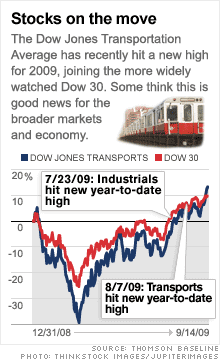The planes, trains and automobiles rally
Transportation stocks may seem so 19th century. But the fact that they've taken part in the market's surge could mean that the economy really is on the upswing.


 |
| The price of copper and performance of transportation stocks have nearly matched each other in recent years as traders looked to them as barometers of manufacturing and consumer spending. |
NEW YORK (CNNMoney.com) -- If you're looking for confirmation that this stock market rally might actually be for real, look no further than the stodgy world of transportation.
The Dow Jones Transportation average hit a new high for the year in mid-August and has continued to climb since then, closing above the 4,000 level on Monday for the first time since November.
And some investing experts think this is an extremely encouraging sign for the economy at large.
Now you might wonder how relevant the transportation sector is these days. Railroad stocks? This is the age of Google, Facebook and Twitter, not the era of robber barons.
Of course, that's true. But the transportation sector is still a vital part of the economy because it is a key gauge of consumer spending.
Without trains, boats, trucks and planes to ship all those netbooks and iPhones to warehouses and retailers, there would be no mobile gadgets available to buy and you wouldn't be able to tweet and update your status on the go.
"If transportation stocks are getting tanked, that means people believe that nothing is getting shipped. The move higher may mean that the economy is bottoming -- even though we're not out of the woods yet," said Frank Ingarra, Jr., co-portfolio manager with Hennessy Funds, a money management firm with about $850 million in assets.
So the spike in the Dow Jones Transportation average, or the transports for short, is worth exploring. The transports consist of 20 key companies within the sector, including leading railroads Union Pacific (UNP, Fortune 500) and CSX (CSX, Fortune 500), airlines JetBlue (JBLU) and Southwest (LUV, Fortune 500), and several truckers and maritime shippers.
And according to a trading rule known as the Dow Theory, it's often considered a bullish sign when the transports and their far more well-known counterpart, the Dow Jones industrial average, both are doing well.
Usually, investors look for one average to "confirm" the other, which means that if one of the two hits a new high for a certain period of time, the other average should also soon hit a new high if the rally has legs.
With the transports now comfortably above the January level of around 3,737, investors got the confirmation they were hoping for: The Dow 30 hit a new high back in late July and hasn't looked back since.
One big reason that the transports have surged -- the average is up more than 85% from the March lows -- is that airline stocks are no longer being priced as if every carrier is on a one-way flight to Chapter 11.
The major airlines traded at extremely distressed levels earlier this year but have roared back on hopes that oil prices are stabilizing and that travel will pick up as the economy recovers.
But airlines aren't the only group in the transport sector to improve on expectations of better times ahead. Last Friday, one of the largest components of the transports, shipper FedEx (FDX, Fortune 500), surprised Wall Street by saying that profits for the next two quarters would be better than expected.
That news helped push shares of FedEx more than 6% higher on Friday and lifted the stock of UPS (UPS, Fortune 500), its top rival and fellow Dow Jones Transportation component, by nearly 4.5%.
The upbeat outlook from FedEx could be a good omen for the broader economy since it may mean that consumers and businesses are becoming more willing to loosen up their purse strings.
John Kosar, director of research with Asbury Research in Chicago, said there are signs that this may be happening in other areas of the financial markets as well.
"A lot of people look at copper as an economic barometer since rising prices could mean that more goods are being made. The performance of the transports is letting you know if goods are being shipped. So that's why they have significance and meeting," he said.
The better-than-expected retail sales for August also appears to confirm that there is a nascent consumer recovery.
Jason Seidl, an analyst with Dahlman & Rose, a boutique investment firm based in New York that covers the transportation, energy and agricultural industries, said he's cautiously optimistic that business is turning around for railroads and truckers.
He said there has been a pickup in auto shipments thanks to the government's Cash for Clunkers program and added that demand to ship chemicals and steel is increasing as well. But, he cautioned, sales and profits for transportation companies are still likely to be lower than a year ago over the next quarter or two.
"We've seen an uptick off the bottom but we're not ready to declare victory yet. On an absolute basis, the numbers still don't look great," he said.
So will this transportation rally continue? FedEx will release its full results on September 17, so it will be interesting to hear if executives are witnessing a real increase in demand or if its new profit guidance is being driven more by lower expenses.
If FedEx executives don't sound too excited about their sales outlook, that could be a cause for concern.
Talkback: Is the recent increase in consumer spending a sign the recession may be over? Are you starting to spend more again? Share your comments below. ![]()

